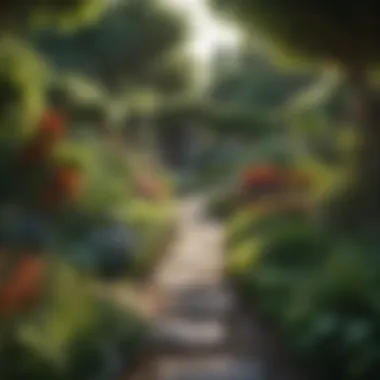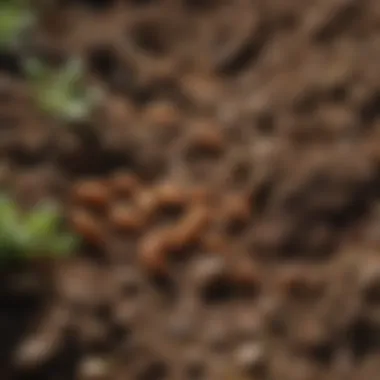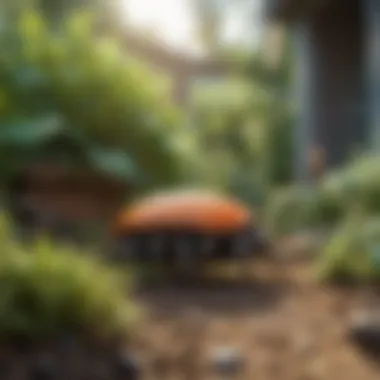Effective Strategies to Eliminate Grubs from Your Garden


Intro
Grubs represent a common adversary for garden enthusiasts, creating significant challenges for maintaining the vibrancy of lawns and plants. Understanding grubs is essential for effectively managing their presence.
Grubs are larvae of various beetles, primarily the Japanese beetle and the European chafer. In their early stages, they can be relatively harmless, but as they grow, they can cause detrimental damage to root systems. This becomes critical during their peak feeding period, which generally aligns with warmer months. Recognizing the signs of grub infestations is the first step towards implementing effective eradication strategies.
This article will guide the reader through the lifecycle of grubs, how to detect them, and the best methods for removal and prevention. By focusing on an integrated approach combining both chemical and organic solutions, homeowners can ensure a healthier garden. Here, we aim to offer practical insights into this pervasive problem and promote sustainable gardening practices.
Understanding Grubs
Understanding grubs is crucial for anyone involved in gardening or lawn care. These larvae can wreak havoc on plants and turf, leading to significant degradation of an otherwise vibrant garden. Identifying the presence of grubs helps to prompt timely actions to mitigate damage. Furthermore, recognizing their life cycles and behaviors allows gardeners to implement effective prevention strategies. This understanding forms the foundation for a robust approach to maintaining a healthy garden. Grubs not only feed on roots but also attract other pests. Hence, addressing their presence can foster a more resilient and balanced ecosystem.
What are Grubs?
Grubs are the larval stage of various beetles. They typically have a soft, white body with a curved shape. Their size can vary but usually is around one to two inches long. Grubs primarily feed on organic matter and the roots of plants in your garden and lawn. This feeding can lead to wilting or dead patches in your landscape. Understanding what grubs are helps in identifying them and taking corrective measures swiftly.
Life Cycle of Grubs
Grubs undergo a complex life cycle that generally consists of four distinct stages: egg, larva (grub), pupa, and adult beetle. The adult beetles lay eggs in the soil, usually in late spring or early summer, which then hatch into grubs. Initially, they are small, but they grow rapidly. After several weeks, they transition into the pupae stage before eventually emerging as adult beetles. Understanding this cycle is essential for controlling their population. Targeting them at their weakest stages often yields the best results.
Common Types of Grubs
Different species of grubs can affect gardens, and understanding these species is important for effective management.
Japanese Beetle Grub
The Japanese beetle grub is a well-known pest in North America. It feeds on the roots of various plants. One key characteristic of this grub is its C-shaped form. It has a light-colored body with a brown head. Controlling this grub is essential because its presence can lead to significant lawn damage. Japanese beetle grubs are drawn to lush, healthy grass, making your garden a prime target. Immediate action can prevent further infestations after recognizing their presence.
June Beetle Grub
June beetle grubs also pose a threat to gardens. They are similar in shape to Japanese beetles but larger and can be less damaging. The key characteristic of June beetle grubs is their size; they tend to be bulkier than other grubs. This species is often less noticeable until the damage becomes apparent. They usually feed on deeper roots, making detection difficult. However, proactive management can minimize harm to your plants, maintaining the vibrancy and integrity of your garden.
European Chafer Grub
European chafer grubs are another common garden pest. They can create considerable damage by feeding on grass roots. The defining characteristic of European chafer grubs is their distinctively darkened body ends, making them recognizable when checking for infestations. They are often found in sandy soils, adding complexity to their management. Being aware of their presence and life cycle helps gardeners to monitor and prevent potential outbreaks, ensuring a healthier garden ecosystem.
Identifying Grub Infestations
Identifying grub infestations is a crucial part of garden management. Early detection plays a vital role in preserving the health of lawns and garden plants. Understanding the signs and symptoms associated with grub damage helps gardeners take corrective action before the problem escalates.
When homeowners notice changes in their garden, they may overlook the underlying causes of these issues. By knowing specific signs of grub activity, they can respond promptly and effectively. This section outlines key indicators of grub presence, guiding you to better diagnose infestations.
Signs of Grub Damage
Brown Patches on Lawn
Brown patches are often the first noticeable sign of grub damage. Larger areas of turf may turn yellow or brown, signaling that the roots are being damaged. This phenomenon occurs when grubs feed on the roots of grass. While many factors contribute to a lawn's health, such as drought or pest issues, patches specifically associated with grubs tend to expand as the infestation grows. Recognizing this characteristic is essential for initial identification and leads to appropriate intervention measures.
Signs of Animal Activity


Another critical aspect of identifying grub infestations is noting animal activity in the garden. Animals such as raccoons and skunks are known to dig in turf and soil to feed on grubs. If you observe these animals on your property or find freshly dug areas in your lawn, it could mean that grubs are present. This sign serves as an indirect indicator of infestation, allowing you to take additional steps in managing the grub population.
Wilting Plants
Wilting is often a sign of a more extensive issue, possibly linked to grubs as well. When grubs consume roots, plants struggle to take up water efficiently. This distress can lead to sudden wilting of plants, which is usually a sign of an underlying problem. Recognizing wilting as a symptom of potential grub activity can help gardeners focus their efforts on addressing these pests before they spread further.
How to Check for Grubs
In addition to identifying visual signs, there are effective methods to check for grubs under the surface. Knowledge of these techniques will empower you to ascertain the presence of grubs accurately.
Soil Testing Techniques
Soil testing techniques provide a direct approach to identifying grubs in your garden. By carefully extracting soil samples, you can examine them for grubs. Most commonly, this involves cutting a small section of the lawn, about one square foot, and peeling back the sod. This practice can reveal the grubs' presence and help you gauge their population density. This method is effective but can be time-consuming, requiring focus and attention to detail.
Visual Inspection Methods
Visual inspection methods are another valuable strategy for identifying grubs. This method involves regularly monitoring your garden for signs of damage, animal activity, or wilting plants. With a keen eye, you can create a habit of inspecting the soil and turf. This proactive approach offers an easy way to detect infestations at an early stage. Though effectiveness could vary depending on the experience of the observer, consistent monitoring can lead to early intervention and effective treatment.
Preventative Measures
Preventative measures play a crucial role in managing grubs. These strategies focus on avoiding the conditions that allow for grub infestations in the first place. One of the benefits of implementing preventative measures is the reduced need for treatments later, which can save both time and resources. By maintaining a healthy garden environment, homeowners can mitigate the risks associated with grub invasions.
Cultural Practices
Soil Health Maintenance
Soil health maintenance is vital for creating an inhospitable environment for grubs. Healthy soil contains beneficial organisms that can naturally control pest populations. A key characteristic of soil health maintenance is the incorporation of organic matter. This practice improves soil structure and promotes microbial activity. It is a beneficial choice for gardeners pursuing both sustainability and effectiveness in pest management. The unique feature of this approach lies in its ability to enhance nutrient availability while also suppressing harmful pests. However, consistent monitoring of the soil's composition is necessary, which can require substantial effort and knowledge.
Proper Watering Techniques
Proper watering techniques contribute to garden resilience by fostering strong plant root systems. A significant characteristic of proper watering is the balance; too little water can stress plants, while too much may encourage pests. This method helps prevent conditions favorable to grubs, making it a popular choice among gardeners. The unique aspect of proper watering techniques is the emphasis on deep watering rather than frequent shallow watering, promoting deep root growth. This can lead to advantages such as healthier plants that are more resistant to pest attacks. Nonetheless, one must be cautious, as overwatering can lead to other problems like root rot, which can ultimately harm plants.
Choosing the Right Plants
Resilient Plant Varieties
Selecting resilient plant varieties is an effective strategy for reducing grub problems. Resilient plants are often bred to withstand various pests and diseases. A key characteristic of these plants is their adaptability to local environments and conditions. They are a beneficial option for those who want to minimize the need for interventions against grubs and other pests. The unique advantage of resilient varieties lies in their ability to thrive despite the pressure from pest populations. On the downside, these plants might come with a higher initial investment and may not always be readily available.
Native Plant Benefits
Native plant benefits are another important consideration when planning a garden. Plants native to an area are typically well-suited for local soil and climate conditions. They require less maintenance and are more resistant to local pest populations. The key characteristic here is that they contribute to local biodiversity. Native plants are a beneficial choice because they can create a balanced ecosystem that supports beneficial insects while deterring harmful ones. Their unique feature is their established relationships with local wildlife, promoting an overall healthier garden environment. However, gardeners should remember that native plants might not always have the varied aesthetic appeal of ornamental species.
Understanding Pest Life Cycles
Understanding pest life cycles helps in timing preventative measures effectively. Knowing when grubs emerge can guide the selection of gardening practices. This is key for planning activities, such as planting or introducing beneficial organisms, at optimal times. By aligning gardening practices with the pest life cycle, one can prevent the establishment of grubs before they cause significant damage. However, it requires some knowledge and attention to detail to track these cycles accurately.
Chemical Removal Methods
Chemical removal methods offer a direct approach to managing grub populations in your garden. These methods often yield quicker results compared to organic methods. When properly applied, insecticides can swiftly reduce grub numbers, providing immediate relief to damaged lawns and plants. However, it is crucial to use these solutions judiciously. Understanding the types of insecticides and their proper application helps in ensuring effective results while minimizing negative impacts.
Insecticides


Types of Insecticides
Various insecticides target grub larvae effectively. Common types include neonicotinoids, pyrethroids, and Bt (Bacillus thuringiensis). Each class of insecticide works differently.
- Neonicotinoids disrupt the nervous system of insects, leading to paralysis and death. This is a significant reason homeowners choose it for grub elimination.
- Pyrethroids, derived from chrysanthemums, are popular for their fast-acting nature. They are designed to control a wide range of pests, making them a versatile option.
- Bt is a naturally occurring bacterium that targets only specific insects. It is noted for its lower environmental impact, making it an attractive choice in eco-conscious gardening.
Selecting the appropriate insecticide depends on your specific situation and preferences, balancing effectiveness with environmental concerns.
Application Techniques
Application techniques greatly influence the success of insecticides. Apply insecticides when grubs are young and active, typically in late spring or early fall when they are feeding near the soil surface.
- Granular Insecticides: These are applied directly to the soil and require watering afterward to help the product reach the grubs.
- Liquid Insecticides: These can be sprayed on the affected areas and often penetrate the soil better than granular types.
Choosing the right application method ensures the insecticide reaches the target pests while reducing potential runoff into surrounding areas.
Timing of Application
Timing is crucial when using chemical methods for grub control. Correct timing aligns with the lifecycle of grubs. For many areas, the optimal periods for application are late spring and early fall. During these times, grubs are actively feeding, making them more susceptible to insecticides. Monitoring your garden for signs of pest activity helps determine the best application times.
Safety Considerations
While insecticides can be effective, they also pose risks.
Environmental Impact
The environmental impact of using chemical insecticides warrants careful consideration. Many insecticides can affect non-target organisms, including beneficial insects like bees. Selecting targeted insecticides can help minimize collateral damage. Educating yourself about environmentally friendly options and specific application protocols can support both effective pest management and environmental conservation.
"Understanding the risks associated with chemical use can guide more responsible gardening practices."
Human Safety Measures
Implementing human safety measures is essential when using insecticides. This includes wearing protective gear, such as gloves and masks, during application. Additionally, it's recommended to keep children and pets away from treated areas until the insecticide has dried or absorbed fully. Understanding and following product safety guidelines enhances safety and ensures a healthier gardening environment.
Managing grubs sustainably requires a balance of effective removal methods while considering the safety of your environment and family.
Organic Removal Alternatives
In the quest to manage grub populations in gardens, organic removal alternatives stand out for their effective and environmentally friendly solutions. These methods aim to minimize harmful impacts on the ecosystem while effectively combating the grub issue. The importance of choosing organic options lies in their ability to sustain long-term garden health. Unlike chemical solutions, organic methods foster a balanced environment within the soil, enhance beneficial insect populations, and promote a self-sustaining gardening system.
Beneficial Nematodes
Beneficial nematodes are tiny, microscopic worms used extensively for biological pest control. These nematodes seek out grubs in the soil, invading their bodies and releasing bacteria that kill the pests. The significance of beneficial nematodes lies in their efficiency and minimal impact on non-target organisms. They work effectively after soil application and can lead to significant reductions in grub populations. Nematodes are a popular choice due to their natural approach and low environmental footprint. While they are generally effective, their success can depend on soil temperature and moisture levels, which are important considerations for gardeners.
Natural Deterrents
Neem Oil
Neem oil is extracted from the seeds of the neem tree and is a powerful natural insecticide. It disrupts the life cycle of grubs by interfering with their hormonal processes, making it difficult for them to develop and reproduce. This characteristic of neem oil makes it a favored choice among gardeners seeking to manage grub populations organically. The unique feature of neem oil is its ability to target specific pests without harming beneficial insects, which is crucial for maintaining biodiversity in the garden. However, it is important to apply neem oil during the early stages of infestation for maximum effectiveness, as its efficacy decreases once the grubs mature.


Diatomaceous Earth
Diatomaceous earth is a naturally occurring sedimentary rock that is crushed into a fine powder and is effective against grubs. The key characteristic of diatomaceous earth is its abrasiveness, which damages the protective exoskeleton of insects, leading to dehydration. It is a beneficial product because it is safe for pets and children, making it an ideal option for residential gardens. The unique aspect of diatomaceous earth is that it remains effective until it becomes wet, so application timing is important to maximize its benefits. Its effectiveness can vary with weather conditions; thus, continuous monitoring is necessary after application.
Cultural Controls
Companion Planting
Companion planting involves growing different plants in proximity for mutual benefits, such as pest deterrence. This strategy is crucial since some plants naturally repel grubs and similar pests. For instance, plants like marigolds can dissuade certain grubs, effectively reducing their numbers. Companion planting is a sustainable choice because it enhances biodiversity and improves soil health. Its advantage lies in its simplicity and integration into regular gardening practices, though it requires some planning and knowledge of plant compatibility.
Organic Mulching Techniques
Organic mulching techniques involve covering the soil with materials like straw, wood chips, or leaves to suppress weeds and retain soil moisture. This method also helps prevent grub infestations by creating a difficult environment for grubs to thrive. The key feature of mulching lies in its dual benefits: it directly impacts grub populations while improving overall soil health. Using organic materials also contributes to soil fertility as they break down over time. While mulching requires consistent application and maintenance, its advantages in preventing grub infestations and enhancing garden health are substantial.
Organic alternatives provide not just immediate relief but develop a long-term strategy for pest management.
Post-Removal Care
Post-removal care is vital in maintaining the health of your garden following a grub infestation. This phase focuses on two major aspects: restoring soil health and monitoring for any future infestations. Implementing effective care strategies can strengthen your garden's resilience against future pest issues, ensuring that plants can thrive.
Restoring Soil Health
Adding Organic Matter
Adding organic matter, like compost or well-rotted manure, plays a crucial role in enhancing soil quality. Organic matter improves soil structure, promotes better drainage, and increases nutrient retention. This is especially important after eliminating grubs, as the soil may have suffered from their feeding activity. Organic matter is a popular choice because it is natural and helps sustain the nearby ecosystem. Its unique feature is its ability to enhance microbial life, which is essential for healthy soil. However, one disadvantage can be the initial investment of time and effort required to incorporate organic materials properly.
Testing Soil pH
Testing soil pH is an important step to understand various soils in your garden. The pH level affects nutrient availability to plants, which is especially critical after a grub issues. A proper pH reading allows for adjustments, ensuring your plants can absorb essential nutrients effectively. Regular soil tests enable gardeners to make informed decisions about amendments. Its distinctive characteristic is the clear indication of acidic or alkaline conditions, which directly influence plant health. On the downside, soil testing kits can sometimes be costly, and results may require expert interpretation for novices.
Monitoring for Future Infestations
Regular Inspections
Conducting regular inspections is fundamental to detecting any renewed grub activity. By checking your garden frequently, you increase the chance of spotting signs of grubs early. One of the key benefits of this practice is that it helps in timely intervention, thus reducing damage to your plants. The unique feature of regular inspections is that they create a routine that encourages deeper familiarity with the condition of your garden. However, this process requires discipline and commitment, which might be difficult for some gardeners.
Maintaining Plant Health
Maintaining plant health is integral to preventing future infestations. Healthy plants are better equipped to withstand pests and diseases. Strategies include proper watering, mulching, and selecting disease-resistant varieties. These measures contribute not only to stronger plants but also to an overall visually appealing garden. One of the key characteristics of maintaining plant health is its preventive nature; when plants thrive, they are less attractive to grubs and other pests. On the flip side, neglecting plant needs can lead to stress and vulnerability, increasing susceptibility to future infestations.
Closure
In this article, we have explored the complex issue of grub infestations in gardens, emphasizing the vital necessity of effective removal strategies. Understanding grubs, identifying their presence, implementing preventative measures, and recognizing the importance of post-removal care are all foundational elements to maintaining a thriving garden ecosystem. The balance between chemical and organic methods for extermination cannot be overlooked, as each has specific applications where it excels.
Summary of Strategies
A comprehensive strategy for grub management includes:
- Curating soil health through regular testing and organic amendments, thus fostering a resilient environment for plants.
- Applying insecticides carefully, considering timing and environmental safety before use.
- Utilizing organic solutions such as beneficial nematodes or natural deterrents like neem oil.
- Engaging in cultural controls that integrate companion planting and mulching to deter grubs.
As emphasized in our discussion, monitoring for potential infestations is equally as crucial as the elimination process itself. Tasks such as inspecting the garden frequently and maintaining plant health should be part of a gardener's routine to ensure any problems are caught early.
A proactive approach combines vigilance with knowledge, ensuring the garden remains healthy and robust in the face of pest problems.
Encouragement for Proactive Gardening
To ensure sustainable gardening practices, it is essential to adopt a mindset of prevention rather than reaction. Consider ways to enhance your garden's resilience by focusing on cultural practices and choosing plants that can withstand threats. Protecting your garden from further grub infestations means adopting methods even before a problem appears.
Investing in soil health, selecting appropriate plant species, and understanding local pest populations are not merely reactive measures. They lay the groundwork for a healthy and flourishing garden. Regular monitoring and maintaining the wellness of your landscape not only protect against grubs but contribute to a more vibrant, resilient outdoor space overall.
In closing, proactive gardening is a powerful tool. It empowers gardeners to take control, effectively nurturing their green spaces while minimizing the risk of pest-related issues.



